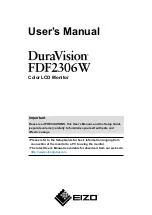
English-56
OSD screen functions (continued)
TILING
You can enlarge an image across multiple screens.
A single large screen can be confi gured with up to 25
monitors. You can also divide the displayed image into up
to 5 pieces horizontally and vertically.
NOTE: A same video signal needs to be input to each
monitor. When different monitors need to be
adjusted so that their tint can be identical, it
is recommended to use a signal distributor
(commercially available).
When TILING is activated, PIP, POP, SBS, and STILL
are disabled.
TILING doesn’t work in the REAL picture size mode.
H MONITORS: Select the number of images obtained by
horizontal division.
V MONITORS: Select the number of images obtained by
vertical division.
POSITION:
Select the area you want to enlarge.
FRAME COMP.: When displaying an image across multiple
monitors, you can select the mode to
compensate for the bezel widths for
smooth and natural display.
ENABLE:
When you select ON, the image in the
selected area is enlarged on the screen.
HEAT STATUS
The statuses of the cooling fan, brightness, and internal
temperature are displayed.
NOTE: The cooling fan starts running according to the
operating temperature or when COOLING FAN is
ON in the SCREEN SAVER menu.
When the operating temperature substantially
exceeds the operation guaranteed range, the
message “TEMPERATURE WARNING!!” is displayed
on the screen.
POWER ON DELAY
You can adjust the delayed time until the power-on mode
is activated at the time of recovery from the sleep mode or
power-on.
The time is selectable from OFF and 2, 4, 6, 8, 10, 20, 30,
40, and 50 seconds.
TERMINAL SETTING
You can select the mode to display the RGB1 (HDMI)
or RGB2 (DVI-D) signal according to their signal format
depending on their source device.
HDMI SIGNAL:
Select this setting when displaying the RGB1 (HDMI) signal.
Select FULL when displaying the signal that uses all 256
levels (from level 0 to 255). This mode is used primarily
when input comes from a computer.
Select LIMITED when displaying the signal that uses 16
to 235 levels of 256 levels for each of R, G, and B. This
mode is used primarily when input comes from a video
device.
HDMI-MODE:
Select this setting when displaying the RGB1 (HDMI) signal.
Select HDMI-HD when the source device is a video
device.
Select HDMI-PC when the source device is a PC.
DVI-MODE:
Select this setting when displaying the RGB2 (DVI-D) signal.
Select DVI-PC when the source device is a PC.
Select DVI-HD when the source device is a video
device.
NOTE: The mounted OPS-compliant module operates
independently from the HDMI SIGNAL, HDMI-MODE,
and DVI-MODE without being affected by their
settings.
DDC/CI
Use to turn ON or OFF the DDC/CI communication function.
Select ON for normal use.
CLOSED CAPTION
You can select to display or hide captions.
OFF:
Captions are hidden.
CC1:
Captions are displayed in sync with the
primary audio.
CC2:
Information (related to the primary
audio) is displayed without sync.
CC3:
Captions are displayed in sync with the
secondary audio.
CC4:
Information (related to the secondary
audio) is displayed without sync.
TT1/TT2/TT3/TT4: Four types of information not related to
the displayed images are displayed. (For
example, news and weather forecast.)
NOTE: Check with each supplier of your video software and
external video devices in advance whether they are
compliant with EIA-608-A.
If their video signals are not compliant with it,
images may not be displayed correctly.
USB UP STREAM
You can select either of the two upstream ports and
distribute the signal to four downstream ports.
EXTERNAL: External computer is selected.
OPS:
OPS-compliant computer is selected.
ADVANCED OPTION RESET
The settings made in the ADVANCED OPTION menus are
reset to the factory defaults.
However, the HDMI-MODE, DVI-MODE, and DDC/CI aren’t
reset.










































